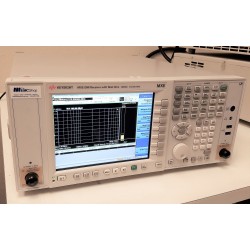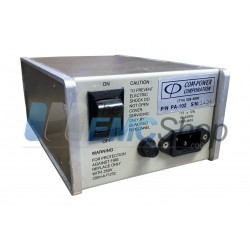No products
Product successfully added to your shopping cart
There are 0 items in your cart. There is 1 item in your cart.
Preamplifiers
- EMC Test Equipment
- Transient Generators
- RF Power Amplifiers
- DC - 300 kHz RF Amplifiers
- 10 kHz - 250 MHz RF Amplifiers
- 10 kHz - 400 MHz RF Amplifiers
- 10 kHz - 1 GHz RF Amplifiers
- 80 MHz - 1 GHz RF Amplifiers
- 1 GHz - 2 GHz RF Amplifiers
- 700 MHz - 4.2 GHz RF Amplifiers
- 1 GHz - 6 GHz RF Amplifiers
- 2 GHz - 8 GHz RF Amplifiers
- 6 GHz - 18 GHz RF Amplifiers
- 18 GHz - 40 GHz RF Amplifiers
- Pulse Amplifiers
- RF Field Strength Probes & Meters
- RF Conducted Immunity
- EMC Receivers/EMI Analyzers
- EMC Antennas
- Coupling Decoupling Networks (CDN's)
- Line Impedance Stabilization Networks (LISN's)
- RF Test Equipment
- EMC Probes
- EMC Measurement & Equipment Software
- Power Supplies
- Electrical Safety Analyzers
- High Precision Laboratory Power Analyzers & Meters
- Anechoic Chambers
- Over-the-Air (OTA) Test Chambers
- EMI RF Shielded Tent Enclosures
- RF Shielded Rooms
- EMC Absorber
- Positioning Equipment
- EMC/EMI Test Setup
- GTEM Cells / TEM Cells
- Reverberation Chambers
- Used RF Anechoic Chambers
- EMC Chamber Filters
- EMC Chamber Shielding Gaskets
- RF Shielded Doors
- Anechoic Chamber Accessories
- Fully Anechoic (FAR) Test Chambers
- Manufacturers
- 3ctest
- AE Techron
- AH Systems
- Amplifier Research
- Boonton
- Com-Power
- Diamond Engineering
- EM Test (Ametek CTS)
- EMC Partner
- EMC Test Design
- Empower High Power RF Amplifiers
- ETS-lindgren
- Log Periodic Dipole Array Antenna
- Near Field Probe Sets
- Double Ridge Horn Antennas
- Biconical Antennas
- Quad Ridge Horn Antennas
- Electric Field Probes
- GTEM's
- Positioners & Tripods
- Loop Antennas
- Biconilog Antennas
- LISN's (Line Impedance Stabilization Network)
- Shielded Enclosures/Rooms
- Monopole Antennas
- Field Generating Antennas
- Fischer Custom Communications
- Haefely Hipotronics
- Haefely EFT/Burst Immunity Test Systems
- Haefely Surge Combination Wave Test Systems
- Haefely Surge Damped Oscillating Wave Test Systems
- Haefely Electrostatic Discharge Test Systems (ESD)
- Haefely Surge Ring Wave Test Systems
- Haefely Surge Telecom Wave Test Systems
- Haefely Magnetic Field Test Systems
- Haefely CDN's (Coupling/Decoupling Networks)
- IFI Amplifiers
- Keysight (Agilent)
- MVG - Microwave Vision Group
- PMM / Narda
- Rohde & Schwarz RF Test Equipment
- Rohde & Schwarz Broadband RF Amplifiers
- Rohde & Schwarz Spectrum Analyzers
- Rohde & Schwarz Compliant EMI Test Receivers
- Rohde & Schwarz Isotropic RF Probes
- Rohde & Schwarz RF Signal Generators
- Rohde & Schwarz RF Switches
- Rohde & Schwarz Oscilloscopes
- Rohde & Schwarz RF Power Meters
- Rohde & Schwarz RF Power Sensors
- Schloder
- Schwarzbeck Mess-Elektronik
- Schwarzbeck Antennas
- Schwarzbeck Automotive Antennas
- Schwarzbeck Broadband Horn Antennas
- Schwarzbeck Biconical Antennas
- Schwarzbeck Logarithmic Periodic Broadband Antennas
- Schwarzbeck Stacked Log-Periodic Broadband Antennas
- Schwarzbeck Biconic Log-Periodic Antennas
- Schwarzbeck Dipole Antennas
- Schwarzbeck Rod Antennas
- Schwarbeck Antenna Baluns / Holders
- Schwarzbeck LISN Line Impedance Stabilisation Networks
- Schwarbeck Decoupling & Absorbing Clamps
- Schwarzbeck Field Probes
- Schwarzbeck Helmholtz Coils
- Schwarzbeck Antenna Masts
- Schwarzbeck Coupling/Decoupling Networks
- Schwarzbeck Antennas
- Solar Electronics
- Teseq (Schaffner)
- Teseq Automotive Transient Generators
- Teseq RF Test Equipment
- Teseq EFT/Burst Generators
- Teseq RF Immunity Generators
- Teseq ESD Guns
- Teseq Surge Generators
- Teseq Harmonics & Flicker Solutions
- Teseq Dips, Interrupts & Variations Equipment
- Teseq Ring Wave Generators
- Teseq Oscillatory Waves Generators
- Teseq Absorbing Clamps / Ferrite Tube
- Teseq EMC Antennas
- Teseq Current Probes
- Teseq Coupling Networks
- Thermo Keytek
- Vicreate
- Compliance Standards
- International (IEC/EN)
- EN/IEC 61000-3-2
- EN/IEC 61000-3-3
- IEC 61000-3-11
- IEC / EN 610000-3-12
- EN/IEC 61000-4-2
- EN/IEC 61000-4-3
- EN/IEC 61000-4-4
- EN/IEC 61000-4-5
- EN/IEC 61000-4-6
- EN/IEC 61000-4-7
- EN/IEC 61000-4-8
- EN/IEC 61000-4-9
- EN/IEC 61000-4-10
- EN/IEC 61000-4-11
- EN/IEC 61000-4-12
- EN/IEC 61000-4-16
- EN/IEC 61000-4-18
- EN/IEC 61000-4-19
- EN/IEC 61000-4-20
- EN/IEC 61000-4-21
- EN/IEC 61000-4-29
- EN/IEC 61000-4-31
- IEC 61000-4-39
- EN/IEC 62132
- SEMI F47 Voltage Sag Immunity
- Product Standards
- Military & Aerospace Standards
- Automotive EMC Standards
- CISPR Standards
- Telecom Testing
- ANSI/IEEE Standards
- FCC Part 15
- FCC Part 30
- International (IEC/EN)
- Application/Test Type
- Radiated Immunity
- Bulk Current Injection Testing
- RF Emissions Testing
- Conducted Immunity
- Conducted Emissions
- Antenna Pattern Measurement
- CE Mark Testing
- Intentional Radiator Testing
- Pulsed HIRF Radar
- Over-the-Air (OTA) Testing
- 5G Test Solutions
- Automotive EMC
- SAR Measurement Equipment
- Radiated Emissions
- Battery Simulator Test Equipment
- Services
- Clearance
Viewed products
-

Teseq LNA 6900 Low...
Frequency range: 9 kHz to 2 GHz...
 View larger
View larger Teseq LNA 6900 Low Noise Amplifier 9 kHz to 2 GHz
New
- Frequency range: 9 kHz to 2 GHz (nominal range); 9 kHz to 4 GHz (utilizable range)
- Gain: typ. 25 dB
- Gain flatness: +0.5 / -3 dB
- RF-Input: N - female, 50 Ω
- RF-Output: N - male, 50 Ω
- VSWR (input): typ. 1.5 (above 20 kHz)
- Noise figure: typ. 4 dB
- 1 dB-compression (output): >+12.5 dBm (119.5 dBμV)
- Intercept point IP3 (output): typ. +33 dBm
- Max. input (linear): -12.5 dBm (94.5 dBμV)
Specifications
| Frequency Range | 1 MHz to 3 GHz (nominal range); 200 kHz to 4 GHz (utilizable range) |
| Gain | 12.5 dB (±0.3 dB flatness) |
| Input | 0 dBm (107 dBμV) |
| Maximum Continuous Power | Greater than 12.5 dBm @ 1 dB compression |
| Connector | N-type 50 Ohms |
| Dimensions | 28 mm x 95 mm x 27 mm |
| VSWR | less than 1.5:1 |
| Weight | 0.27 Lb's (127 grams) |
Test Equipment Description
The Teseq LNA 6900 is a low noise amplifier with 25 dB of gain covering the nominal frequency range 9 kHz to 2 GHz and can be used up to 4 GHz. With its high gain and low noise figure, it will significantly increase the sensitivity of virtually all spectrum analyzers and other RF measuring instruments. All measuring instruments have a ‘noise figure’, which is a measure of how good the instrument is at measuring low level signals, the lower this figure, the better, although the lowest signal level will still be governed by the measurement bandwidth. A typical spectrum analyzer may have a noise figure of 20 dB or more, whereas a typical receiver may have a noise figure of 10 dB. The preamplifier has a noise figure of typically 4 dB, significantly enhancing the low level performance of such instruments, enabling signals that were previously masked by noise to be seen.
The low noise amplifier can be connected directly to the RF input (N) of the spectrum analyzer or EMI-receiver. If the LNA 6900 is used with the Teseq receiver SCR 35xx / SMR 45xx, the power supply is provided directly by the receiver via the cable LE 237. Alternatively the power supply unit PSU 6000 can be used.
Features & Specifications of Teseq LNA 6900:
- Frequency range: 9 kHz to 2 GHz (nominal range); 9 kHz to 4 GHz (utilizable range)
- Gain: typ. 25 dB
- Gain flatness: +0.5 / -3 dB
- RF-Input: N - female, 50 Ω
- RF-Output: N - male, 50 Ω
- VSWR (input): typ. 1.5 (above 20 kHz)
- Noise figure: typ. 4 dB
- 1 dB-compression (output): >+12.5 dBm (119.5 dBμV)
- Intercept point IP3 (output): typ. +33 dBm
- Max. input (linear): -12.5 dBm (94.5 dBμV)
- DC-power supply: 11 to 15 V
- DC-current: approx. 112 mA
- DC-connector: ODU-female, plus on inner conductors
- Operating temperature range: 0° to 40°C
- Storage temperature range: -20° to 60°C
- Size (W x D x H) (without connectors): 27 mm x 50 mm x 27 mm
- Size (W x D x H) (including connectors): 28 mm x 95 mm x 27 mm
- Weight: approx. 127 g






















